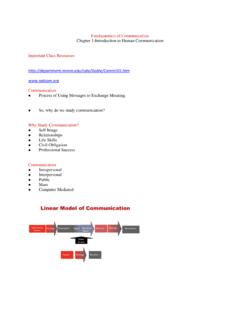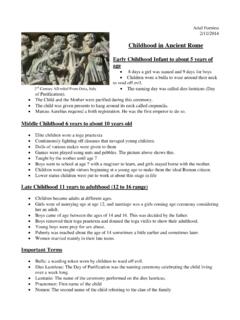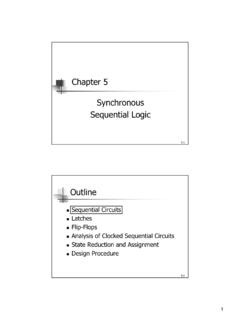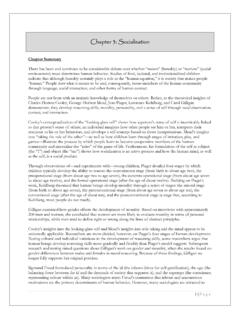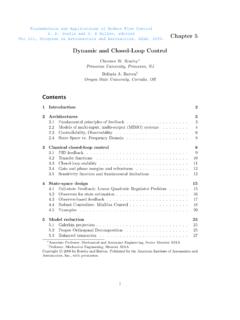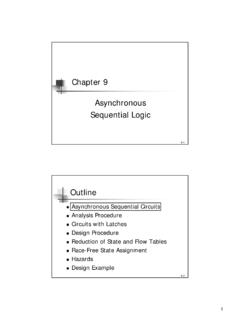Transcription of Fundamentals of Communication Chapter 1-Introduction to ...
1 Fundamentals of Communication Chapter 1-Introduction to Human Communication Important Class Resources Communication Process of Using Messages to Exchange Meaning. So, why do we study Communication ? Why Study Communication ? Self Image Relationships Life Skills Civil Obligation Professional Success Communication Intrapersonal Interpersonal Public Mass Computer Mediated Interactive Communication Model Fundamentals of Communication Chapter 10- Topic Selection and Audience Analysis Choosing a Topic Personal Inventory Brainstorming Narrowing a topic What topics interests you & audience? What topics do you know about & your audience want to know? What topics are you committed to (passion and conviction)? What topics can you find research on?
2 Visual Brainstorming Audience Analysis Voluntary vs. Captive Demographics Interest and Knowledge Attitudes, Values, and Beliefs Methods of Aud. Analysis Observation Inferences Questionnaires Micro targeting Adapting to an Audience Behavior Verbal/Nonverbal Topic Purpose Fundamentals of Communication Chapter 11- Being Credible and Using Evidence Why are you telling us about this topic in this manner? Why = Goal You = Speaker and Knowledge Us = Reason to Listen Topic = Appropriate Manner = Organization & Strategy Credibility Competence Trustworthiness Dynamism Common Ground How do you establish credibility? Research Where would you go if your wanted to find information on a topic that interests you? 4 basic places Yourself Library Internet Interview and Authority Yourself as Research Source Own experience and knowledge Can enhance credibility Libraries provide rich information on speech topics.
3 Reference Desk. Indexes Databases Internet as Research Source Who's the author? Reliable source? Is it biased? Complete and accurate info? Intended audience? Up to date info? Good grammar and appropriate language? Web-master identified? Make Research Easier Have a clear purpose Start early Take notes and photo copy Record all possible citation information Evidence Evidence is material used to support claims a speaker makes. Makes ideas more clear, compelling, and dramatic Strengthens a speaker's opinions Demonstrates ideas Allows speaker's to achieve derived credibility Evaluating Sources Clear Verifiable Competent Objective Relevant Seven Types of Supporting Materials Examples Surveys Testimonials Statistics Analogies Explanations Definitions Examples Instances used to make a point, dramatize an idea, or personalize information Undetailed- quick reference.
4 Detailed -in-depth descriptions of instances. Hypothetical -identified clearly- What If Stories are extended examples in which a great deal of information is woven into a coherent account. Surveys Reliable source Broad sample Who was included? Representative sample Who performed the survey? Why? Statistics Numbers that summarize or demonstrate relationships Should be limited in a speech Round off numbers so listeners can understand and retain them Select statistics that are not dated. Example: North Americans make up only 6% of the world's population, yet they consume 40% to 60% of the planet's resources. Testimonials Expert with opinions/conclusions of worth Subject expertise Personal experience, Study/research, First hand proof More believable because of this source Analogies Comparison of things Clarification Not proof, but useful as a way to clarify or illustrate.
5 Explanations and Definitions Explanations- Clarify an idea by using the audiences point of view. Definitions- meaning through description, simplification, examples, analysis, comparison, explanation, or illustration. Ethics and Source Credibility True to yourself Ethical goals and purpose Employ ethical means and be honest Obligation to use accurate info Cite the sources Represent the source accurately and fairly. Using Evidence Speech Anxiety Jerry Seinfeld said that public speaking is the most people's biggest fear, more than death. So most people would rather be in the casket than giving the eulogy. What happens to you when you get nervous? Big Seven Sources of Speech Anxiety Fear of Failure Fear of Disapproval Fear of Unknown Fear of the Spotlight Fear of the Audience Fear of Breaking the Rules Fear of Fear Controlling Speech Anxiety Goal is not to eliminate but to learn to CHANNEL that energy.
6 Nervousness is NATURAL. Nervousness can benefit the speech by adding ENERGY and can ENLIVEN your delivery. Some Coping Strategies Know how you react to stress. Know your strengths and weaknesses. Know speech principles. Know your audience Know your speech Believe in the topic View speech making positively. Project control. Test your message Practice. Learn from Experience Fundamentals of Communication Chapter 4- Language and Meaning Language A collection of symbols, letters or words with arbitrary meanings that are governed by rules and used to communicate. Symbols Arbitrary they are not intrinsically connected to what they represent Ambiguous their meanings are not clear cut or fixed Abstract they are not concrete or tangible Because symbols require interpretation, Communication is an ongoing process of creating meanings.
7 Language Use is Rule-Guided Culturally Bound Organizes and Clarifies Reality Sapir-Whorf Hypothesis Language is Arbitrary & Abstract Denotative Meaning Connotative Meaning Language Use (Obstacle or Enhancement). Grammatical Errors Colloquialisms Cliches Euphemisms & Doublespeak Slang Profanity Jargon Regionalism Sexist, Racist, and Heterosexist Language Improving Language Skills Avoid Intentional Confusion (empty language). Use Descriptiveness Be Concrete Differentiate Observations/Inferences Cultural Competence Each of us has an ethical responsibility to guard against engaging in uncivil speech as well as not tolerating it from others. Fundamentals of Communication Chapter 3 Listening and Critical Thinking Hearing A physiological activity that occurs when sound waves hit our eardrums Listening Listening Active process Receive and Constructing Meaning Responding to Messages Verbal and Nonverbal 4 types of Listening Active Empathetic Critical Enjoyment Barriers to Listening Noise Physical Mental Factual Semantic Perception of Others Status Stereotypes Sights and Sounds Yourself Egocentrism Defensiveness Experiential superiority Personal Bias Pseudolistening Becoming a Better Listener Listen and think critically Use verbal Communication effectively Use nonverbal Communication effectively Listening in the Workplace Be self-aware Monitor your
8 Nonverbal behaviors Minimize interruptions Ask nonaggressive questions Summarize what the other says to assure you understand Listening in the Classroom Use lecture listening Find areas of interest Remain open Work at listening Avoid distractions Listen for and note main ideas Take effective notes Listen for lecture cues Listening to Media Become a critical consumer of media information Develop information literacy Recognize when you need information Know where to find the information you need Check your perceptions of electronic messages Critical Thinking/Listening Analyze situation and message Communication Context Speaker's Argument and Support Material Speaker's Observations or Inferences Speakers Credibility Be an Ethical Listener Recognize the sources of your own conversational style habits Monitor your Communication Apply general ethical principles to your responses Adapt to others Fundamentals of Communication Chapter 12- Organizing Your Presentation Overall Organization Strategy Tell us what you are going to tell us Tell us Tell us what you told us Big difference is that a reader can reread.
9 Must make it easy for listener with clear organization. Defining Your Purpose I want my speech to _____. At the end of my speech, I want listeners to_____. To achieve my goal I need to _____ ( entertain, narrate, inform, persuade.). Thesis Statement The main idea of the speech Captures the key message in a short and precise sentence that listeners can remember easily Is one listeners can grasp at the beginning of your talk and remember after you have finished Refines what you've already done in limiting your topic and defining your purpose The Body is the Substance Supports the central idea or thesis statement. 5-10 minute speeches should have no more that three main points. 11-20 minute speeches can have more points.
10 Questions and answers need more time. Prepare the body of the speech prior to the introduction and conclusion. Organization Strategy A-M-T-O-B-U-L. Attention Motivation Thesis Overview Body Underview Last Thought Organization Patterns Time Sequence Cause/Effect Problem/Solution Topical/Sequence Organize the Body- Develop the Key Ideas Four S's Signpost State Support Summarize (Transition). Designing the Introduction Keys to a Good Conclusion Be Clear Be Memorable Be Brief Summarize the key points Provide closure Summarize Key Points Review the major ideas Listener's last chance to hear and remember the main points. Repetition reinforces the ideas Helps build to the logical conclusion Provide Closure If summary is the logical end, then closure is the psychological end.
